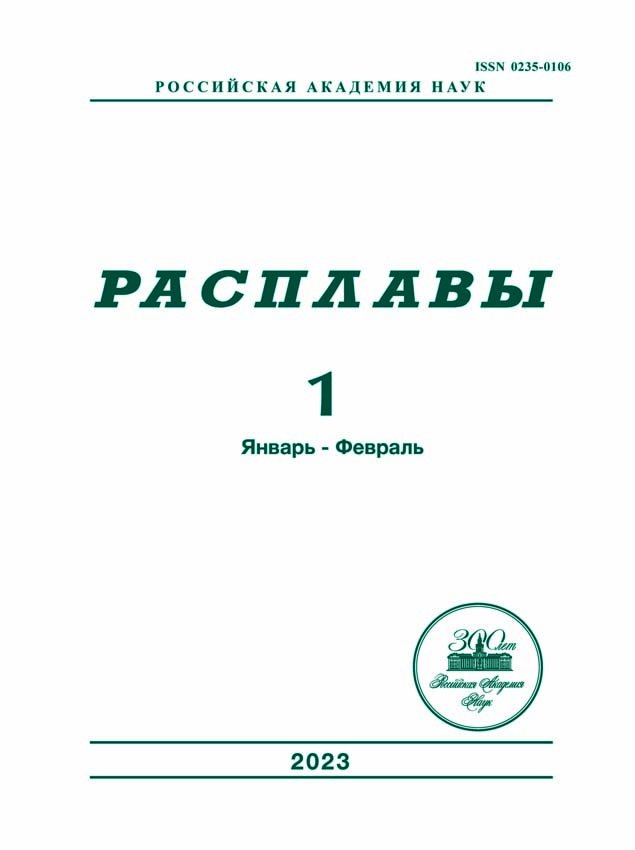USING AB INITIO DATA OF MOLECULAR DYNAMICS TO ANALYZE STRUCTURAL UNITS AND THEIR STABILITY IN BORON-OXYGEN NETWORK OF MELT B2O3–Na2O
- Autores: Yuryev A.1, Tsymbalist M.1, Samoylova M.1, Khokhryakov A.1
-
Afiliações:
- Institute of metallurgy, Ural Branch of RAS
- Edição: Nº 1 (2023)
- Páginas: 22-38
- Seção: Articles
- URL: https://journals.rcsi.science/0235-0106/article/view/138530
- DOI: https://doi.org/10.31857/S0235010623010115
- EDN: https://elibrary.ru/HCLEND
- ID: 138530
Citar
Resumo
The aim of this work was to develop a computational-theoretical method for a detailed study of the geometry and statistical characteristics of local structural groups of complex liquids such as alkaline borate systems, tending to form a bulk boron-oxygen network. The technique was worked out a melt 30Na2O–70B2O3 as an example at T = 1273 K. Ab initio molecular dynamics was used, implemented in the VASP program code for a supercell consisting of 250 atoms. The ion coordinates obtained at each step were used to obtain statistically significant information about the detailed structure of the melt. Using the original program developed for this purpose, we determined the partial radial distribution functions of the of atoms and analyzed all the closest coordinations found in the model around each type of ions, also the types and number of stable groups, bond lengths and angles in them. In addition, the tetrahedrality criterion for units BO4 and ВB4 were defined. Almost regular triangles (~80% of boron atoms) and tetrahedra (~19% of boron atoms) with a boron ion in the center and oxygen ions at the vertices proved to be the basic structural units. These simple structures form a boron-oxygen network connected by common (bridging) oxygen atoms. This network includes almost all boron atoms. Superstructural units, namely combinations of three or more basic structures have been found. For example, two triangles and one tetrahedron are forming rings of six alternating boron and oxygen atoms. Besides, the existence of rings that are formed from four basic structural units were discovered, but they in contrast to six-atom rings, are not planar formations. The proposed technique allows to obtain almost any details on the structural features of systems of this type, in particular, to answer the important question about the number of bridging and non-bridging oxygen atoms. It turned out that there are approximately 86% of bridging oxygens in studied system. The approach used considers correctly covalent and ionic bonds in liquid systems based on network-forming oxides and modifier-oxides. That will make possible to study the change in local structural characteristics and its dependence on concentration and temperature explaining the behavior of various physico-chemical properties.
Sobre autores
A. Yuryev
Institute of metallurgy, Ural Branch of RAS
Autor responsável pela correspondência
Email: yurev_anatolii@mail.ru
Russia, Yekaterinburg
M. Tsymbalist
Institute of metallurgy, Ural Branch of RAS
Email: yurev_anatolii@mail.ru
Russia, Yekaterinburg
M. Samoylova
Institute of metallurgy, Ural Branch of RAS
Email: yurev_anatolii@mail.ru
Russia, Yekaterinburg
A. Khokhryakov
Institute of metallurgy, Ural Branch of RAS
Email: yurev_anatolii@mail.ru
Russia, Yekaterinburg
Bibliografia
- Krogh-Moe J. // Phys. Chem. Glasses 1969. 6. 2. P. 46–54. https://doi.org/10.1016/0022-3093(69)90025-8
- Yano T., Kunimine N., Shibata S., Yamane M. // J. Non-Crystalline Solids. 2003. 321. P. 147–156. 10.1016/S0022-3093(03)00159-5' target='_blank'>https://doi: 10.1016/S0022-3093(03)00159-5
- Osipov A.A., Osipova L.M. // GlassPhys. Chem. 2009. 35. P. 121–131. https://doi.org/10.1134/S1087659609020011
- Handa K., Kita Y., Kohara S. // J. Physics and Chemistry of Solids. 1999. 60. P. 1465–1471. https://doi.org/10.1016/S0022-3697(99)00143-2
- Fábián M., Sváb E., Proffen T., Veress E. // J. Non-Crystalline Solids 2010. 356. P. 441–446. https://doi.org/10.1016/j.jnoncrysol.2009.12.013
- Guillaume F., Charpentier T., Seitsonen A. P., Takada A., Lazzeri M., Cormier L., Calas G., Mauri F. // Phys. Rev. Lett. 2008. 101. 065504. https://doi.org/10.1103/PhysRevLett.101.065504
- Bubnova R.S., Filatov S. K. Vysokotemperaturnaya kristallohimiya boratov i borosilikatov. [High-temperature Crystal Chemistry of Borates and borosilicates]. Saint-Petersburg: Nauka, 2008. [In Russian].
- Kaiura G.H., Toguri J.M. The viscosity and structure of sodium borate melts // Physics and chemistry of glasses // Phys and Chem Glasses. 1976. 17. № 3. P. 62–69.
- Shartsis L., Capps W., Spinner S. Viscosity and electrical resistivity of molten alkali borates // J. Am. Cer. Soc. 1953. 36. № 2. P. 35–43.
- Claes P., Coq J.L., Glibert J. // Electrochimica Acta. 1988. 33. P. 347–352. https://doi.org/10.1016/0013-4686(88)85027-8
- Melchakov S.Y., Khokhryakov A.A., Samoilova M.A., Ryabov V.V., Yagodin D.A. // Glass. Phys. Chem. 2022. 48. № 3. P. 174–179. https://doi.org/10.1134/S1087659622030063
- Khokhryakov A.A., Melchakov S.Y., Samoilova M.A., Ryabov V.V. // Inorganic materials. 2022. 58. № 5. P. 538–543. https://doi.org/10.1134/S0020168522050053
- Cristos-Platon E., Varsamis // Phys. Rev B. 2002. 65. P. 104203–104217. https://doi.org/10.1103/PhysRevB.65.104203
- Ohkubo T., Takahiro O., Tsuchida E., Gobet M., Sarou-Kanian V., Bessada C., Yasuhiko I. // J. Phys. Chem. B. 2013. 117. P. 5668−5674. https://doi.org/10.1021/jp312486m
- Yuryev A.A., Samoylova M.A. // J. Structural Chemistry. 2020. 61. 5. P. 681–687. https://doi.org/10.1134/S0022476620050029
- Xu Q., Kawamura K., Yokokawa T. // J. Non-Cryst. Solids. 1988. 104. P. 261–272. https://doi.org/10.1016/0022-3093(88)90397-3
- Kita Y., Misawa M. Umesaki N., Kirihara T., Fukunaga T., Iida T. ISIJ International. 1993. 33. № 1. P. 188–194. https://doi.org/10.2355/isijinternational.33.188 18. Umesaki N., Kita Y., Kirihara T., Iida T., Fukunaga T., Misawa M. // J. Non-Crystalline Solids. 1994. 177. P. 200–207. https://doi.org/10.1016/0022-3093(94)90531-2 19. Pooja S., Pente A.A., Mandar D.S., Chowdhri I.A., Sharma K., Goswami M., Kalsanka T.S., Sadhana M. // J. Phys. Chem. B. 2019. 123. P. 6290–6302. https://doi.org/10.1021/acs.jpcb.9b03026 20. Kresse G., Furthmuller J. // Phys. Rev. B. American Physical Society. 1996. 54. P. 11169–11186. https://doi.org/10.1103/PhysRevB.54.11169 21. Tsymbalist M.M., Yuryev A.A. Svidetel’stvo o gosudarstvennoj registracii programmy dlya EVM № 2 020 618 833 programma dlya EVM “StatXYZ”. [Certificate of state registration of the computer program No. 2 020 618 833 computer program “StatXYZ”]. [In Russian]. 22. Errington J.R., Debenedetti P.G. // Nature. 2001. 409. P. 318–321. https://doi.org/10.1038/35053024 23. Kumar P., Buldyrev S.V., Stanley H.E. PNAS. 2009. 106. № 52. P. 22130–22134. www.pnas.org/cgi/doi/10.1073/pnas.0911094106 24. Alderman O.L.G. // J. Phys. Chem. C. 2015. https://doi.org/10.1021/acs.jpcc.5b10277 25. Majérus O., Cormier L., Calas G., Beuneu B. // Phys. Rev. B. 2003. 67. P. 024210–024217. https://doi.org/10.1103/PhysRevB.67.024210 26. Kamitsos E.I., Chyssikos G.D. Solid State Ionics 1998. 105. P. 75–85. https://doi.org/10.1016/S0167-2738(97)00451-7
Arquivos suplementares















